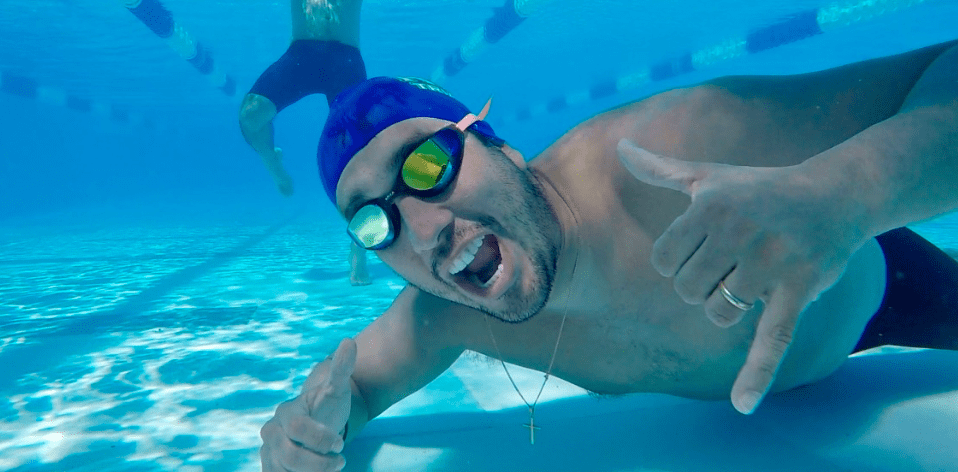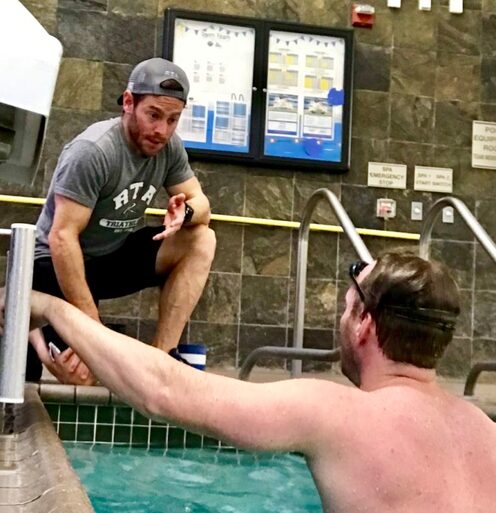|
Learning to Breathe Properly While Swimming Have you ever tried to swim laps in the pool and felt completely “gassed” after only 1 or 2 lengths? If you answered, ‘yes,’ you are not alone. This feeling is likely NOT indicative of a lack of fitness, but rather an undeveloped breathing rhythm. Learning to breathe properly while swimming freestyle is one of the most difficult things for new triathletes/swimmers to master. It takes time to master and the time it takes is different for everyone. Frequency (not duration) in the pool (i.e. 3, 4, 5+ days per week) and working with an experienced coach will help speed up the process. However, it’s important to be patient and not become frustrated. Once one gets the hang of it, their “swim curve” takes off! Below are a few helpful tricks I have learned while working with triathletes over the last decade who are trying to learn how to breathe properly while swimming. HOW TO BREATHE PROPERLY WHILE SWIMMING: The key to breathing properly while swimming freestyle is ensuring a full exhale under water and ONLY inhaling above the water. This is VERY IMPORTANT. If you find yourself exhaling and inhaling when you come to the side for air you will quickly become out of breath. I will often explain this to athletes struggling with their breathing and most of the time they nod and tell me that’s exactly what they are currently doing. However, nearly every time I ask them to focus 100% on their breathing (and nothing else) they discover they are indeed letting at least a tiny bit of air out above the surface of the water before inhaling. When you hold your breath between inhalations, as small and fractional as it may seem, this incremental build-up of carbon dioxide is called “stacking.” And it doesn’t take long for this build-up to begin to cause fatigue. When learning something new, I have found that it is most effective to be hyper focused on only 1 thing at a time. If you try to focus on 2, 3, 4+ things at once, you won’t do any of them very well. Therefore, as it relates to breathing, it is important to be cognizant of ONLY inhaling when you come to the side. It sounds like common sense, but being 100% focused on when and how you’re breathing will make a difference. As simple as it sounds, this concept and breathing in general is one of the most challenging things for new swimmers to master. HELPFUL TIPS: *Hold your breath for a brief second following your inhalation before beginning to exhale under water. *When your face is in the water, slowly exhale, BUT don’t completely exhale until it’s time to rotate and inhale, THEN let it ALL out just before your face reaches the surface of the water. If done correctly, you will make a BIG BUBBLE of water at the surface. This helps create a negative pressure and helps ensure you are only INHALING when your mouth is above the surface of the water. At this point you’ll be ready to inhale and refill your lungs with air. (once you’re out of breath, you WANT AIR, and if you can’t get air right away you start to go into oxygen deficit)* Check out the video below for a good visual of what I’m describing above. – Breathe through your mouth and nose – Your mouth should be WIDE open when you rotate to the side to inhale. Your mouth should NOT look like you are inhaling air through a straw. – Don’t feel as if you have to keep your face in the water for such a long time… When you want air, just blow out whatever you have left as you rotate to get air. YOU ultimately control how slow/fast you exhale under water and when you get air. – Try holding your breath for a brief second before beginning to exhale under water. This works for some people but not all. – Swimming with a pull buoy, buoyancy shorts/pants can help reduce your heart rate by giving your legs less work to do. A lower heart rate will make it easier to learn to breathe properly and find a good rhythm that works for you. I do NOT recommend with the buoyancy pants regularly once breathing proficiency is achieved. – Play with your head position. If you tilt your head up slightly, you will have to “travel” less (compared if you’re looking straight down) to get your mouth to the surface to breathe. This can also be helpful in the open water when the water isn’t as calm as the pool. Keep in mind the this is a careful balance because the more you tilt your chin up, the more your hips & legs will drop, creating a ton of drag and making it more difficult to move through the water. – Plan to breathe every other stroke (every 2 strokes) when learning to breathe. Pick whatever side feels most comfortable. Righty’s, usually find breathing to the right is easiest, but it doesn’t apply to everyone. Taking additional strokes in between breaths will mean your face is in the water longer making it more difficult. Once you get this down, you can begin practicing bi lateral breathing (every 3 strokes). It is not necessary to take more than 3 strokes between breaths. Generally speaking breathing every other stroke is good for Race and Hard efforts. Breathing every 3 strokes is a great way to balance out your stroke and should be used when not racing or swimming hard. Comments are closed.
|
Categories
All
Archives
July 2024
|
RTA TriathlonRTA is a comprehensive triathlon coaching organization and fully supported USAT sanctioned triathlon club.
We are based in Ridgewood, NJ and coach triathletes of all abilities from across the country. Our mission is to make you a better triathlete. Contact us when you're ready to take your "game" to the next level. |
|
|
Quick Links |
Let's get social
RTA Triathlon
Copyright © 2022
Copyright © 2022



 RSS Feed
RSS Feed
